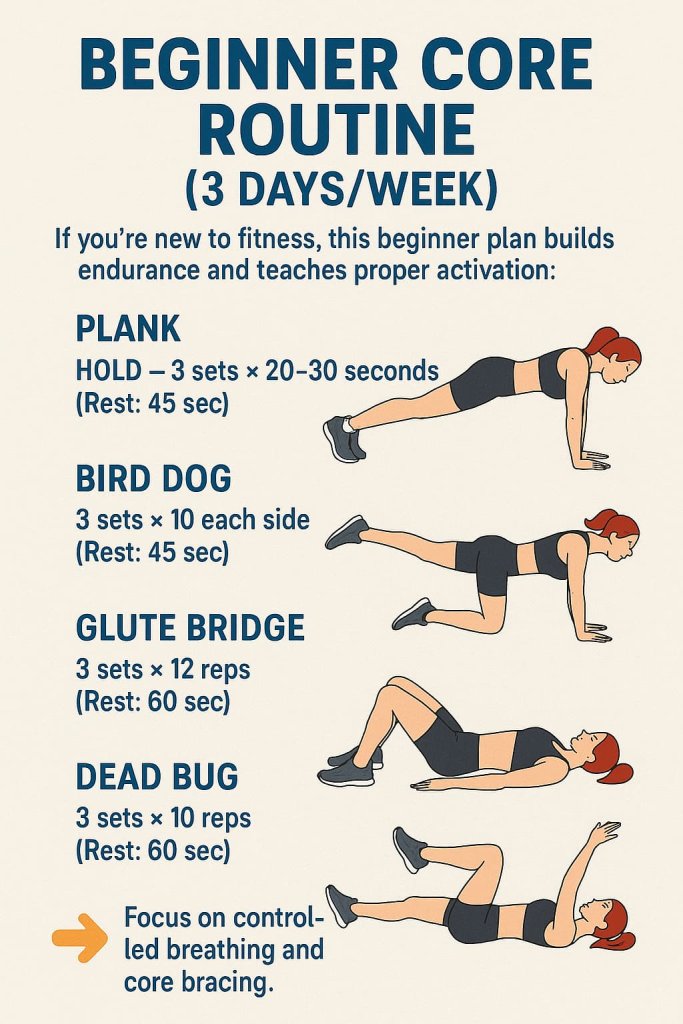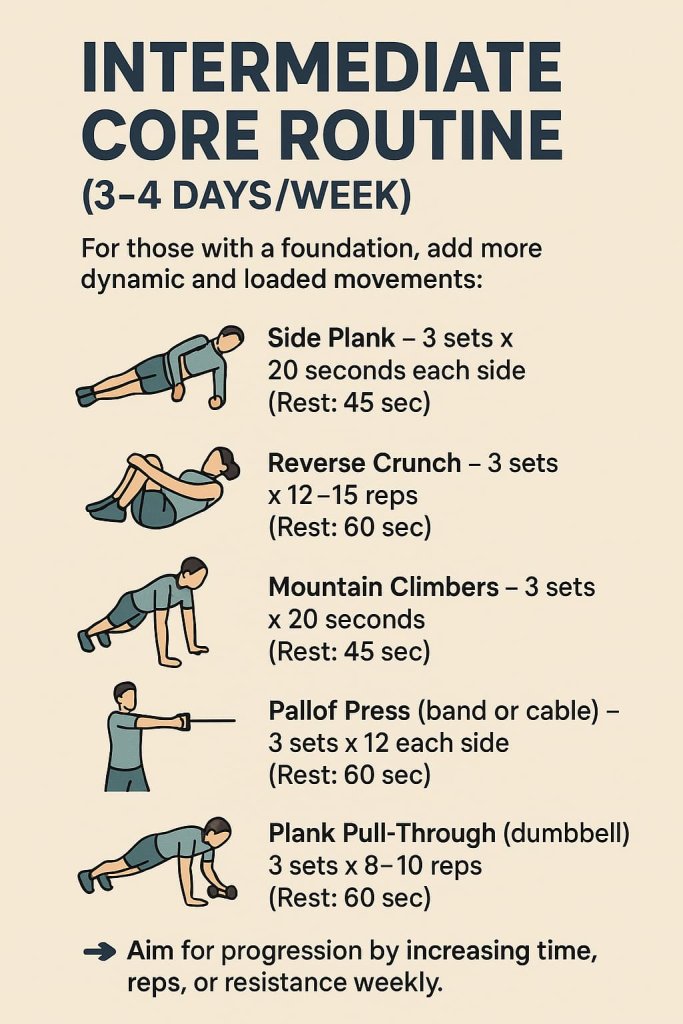The best core workout routine includes compound lifts, stability holds, and anti-rotational exercises—not just endless sit-ups. A strong core is more than just visible abs—it’s the foundation of strength, posture, and balance.

In this guide, you’ll find ready-to-follow core workout routines for beginners, intermediates, and advanced lifters, plus expert-backed tips and exercises that go beyond crunches. We’ll also explain why core strength matters, the science behind functional training, and how to integrate these workouts into your weekly plan.
👉 If you want a detailed breakdown of the most effective movements, check out our complete guide on the best core exercises.
Core Workout Routines by Level
Beginner Core Routine (3 Days/Week)

If you’re new to fitness, this beginner plan builds endurance and teaches proper activation.
| Exercise | Sets × Reps/Time | Rest |
|---|---|---|
| Plank Hold | 3 × 20–30 sec | 45 sec |
| Bird Dog | 3 × 10 each side | 45 sec |
| Glute Bridge | 3 × 12 | 60 sec |
| Dead Bug | 3 × 10 | 60 sec |
👉 Focus on controlled breathing and core bracing.
Intermediate Core Routine (3–4 Days/Week)

For those with a foundation, add more dynamic and loaded movements.
| Exercise | Sets × Reps/Time | Rest |
|---|---|---|
| Side Plank | 3 × 20 sec each side | 45 sec |
| Reverse Crunch | 3 × 12–15 | 60 sec |
| Mountain Climbers | 3 × 20 sec | 45 sec |
| Pallof Press (band or cable) | 3 × 12 each side | 60 sec |
| Plank Pull-Through (dumbbell) | 3 × 8–10 | 60 sec |
👉 Aim for progression by increasing time, reps, or resistance weekly.
Advanced Core Routine (4–5 Days/Week)
This plan incorporates heavy lifts, static holds, and advanced stability work.
| Exercise | Sets × Reps/Time | Rest |
|---|---|---|
| Deadlift | 4 × 5 | 2–3 min |
| Overhead Squat | 4 × 8 | 2 min |
| Hanging L-Sit Hold | 3 × 15–30 sec | 90 sec |
| Stability Ball Rollout | 3 × 12 | 75 sec |
| Dumbbell Windshield Wipers | 3 × 8 each side | 90 sec |
👉 Perform heavy lifts first, then stability work.
Why Core Strength Matters
Training your core is about much more than visible abs. The core includes the abs, obliques, transverse abdominis, spinal erectors, glutes, and pelvic floor. Together, these muscles stabilize your spine, improve coordination, and enhance movement efficiency.
Key Benefits of Core Training:
- Prevents back pain and injuries (Mayo Clinic, 2025).
- Improves posture and balance.
- Boosts athletic performance (running, lifting, swimming).
- Makes everyday tasks easier—lifting, bending, twisting.
- Supports breathing and endurance (Peloton Blog, 2025).
Best Core Exercises Explained
Compound Core Builders
These full-body lifts engage deep stabilizers:
- Deadlifts – Strengthens posterior chain and abs.
- Overhead Squats – Ultimate stability test.
- Farmer’s Carries – Build grip, balance, and endurance.
Bodyweight Core Staples
No equipment? No problem:
- Plank Variations – Side, forearm, and shoulder-tap planks.
- Bird Dog & Dead Bug – Improve spinal health and stability.
- Mountain Climbers – Add a cardio burn.
- Hollow Hold – Advanced static control.
Dumbbell & Weighted Core Work
Great for progression:
- Plank Pull-Throughs – Anti-rotational challenge.
- Bird-Dog Rows – Stability + load.
- Weighted Russian Twists – Rotational power.
- Single-Arm Overhead Carry – Builds obliques.
Deep-Core & Anti-Rotation Training
Essential for long-term spinal health:
- Pallof Press – Bracing strength.
- Stability Ball Rollouts – Core extension control.
- Side Plank with Hip Dip – Oblique power.
- Hanging L-Sit Hold – Strength + flexibility.
Tips for Core Training Success
- Frequency: 2–3 sessions per week is optimal.
- Progression: Increase time, weight, or reps gradually.
- Form First: Avoid arching your lower back.
- Mix It Up: Use static holds, dynamic moves, and carries.
- Combine with Nutrition: Visible abs require low body fat.
- Train After Main Lifts: Keep core fresh for heavy lifts.
External Resources
- Mayo Clinic – Core Strength Training Guide
- Verywell Fit – 20-Minute Core Routine
- Tom’s Guide – Core Workouts
FAQs about Core Workout Routine
1. How often should I do core workouts?
2–3 times weekly. Daily core work may cause strain.
2. Can core workouts reduce belly fat?
No. Fat loss requires a calorie deficit, though core training defines muscles.
3. Are planks better than crunches?
Yes—planks activate stabilizers without straining the spine.
4. What equipment do I need?
Bodyweight is enough, but resistance bands, dumbbells, and stability balls add challenge.
5. How fast can I see results?
Strength improves within 4–6 weeks. Visible abs depend on diet.
6. Can I do core training with back pain?
Yes—stick to bird-dog, glute bridges, and planks. Avoid heavy twisting.
7. Should I train core before or after my workout?
After your main workout, so heavy lifts aren’t compromised.
Conclusion
A core workout routine should go beyond crunches. By using compound lifts, bodyweight stability drills, weighted carries, and anti-rotational exercises, you’ll build lasting strength, balance, and resilience.
👉 Ready to upgrade your training? Start with the beginner plan, progress through intermediate, and eventually master advanced moves. For more exercise ideas, explore our detailed guide on the best core exercises.
